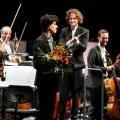Leaderboard
Popular Content
Showing content with the highest reputation on 11/01/2017 in all areas
-
I think it's good work. Funny how you mix a "forest" atmosphere with "urban" sensations...1 point
-
Hello! You may perhaps have seen the collaboration topic for Theme and Variations on a Dutch folk song ''Sinterklaas is jarig''. Since I don't get any variations, I have decided that the piece is finished now. I want to thank all participants for their submissions, which are all great! It was fun to have so many people submit a variation, so maybe we can do more collaboration projects on the basis of simple songs. Theme: ''Sinterklaas is jarig.'' For more info, see below. I made a mistake by confusing the song ''Sinterklaas is jarig'' with ''Oh! Kom maar eens kijken.'' The latter is incorrect. Variation I. @MusicianXX12 Varation II. @Luis Hernández Variation III. @ilv Variation IV. @MusicianXX12 Variation V. @Maarten Bauer Variation VI. @Maarten Bauer Variation VII. @DirkH Variation VIII. @Aure_liano BACKGROUND INFORMATION The theme is a Dutch / Flemish Saint Nicholas (Sinterklaas) song. ''The feast of Sinterklaas celebrates the name day of Saint Nicholas on 6 December. The feast is celebrated annually with the giving of gifts on St. Nicholas' Eve (5 December) in the northern parts of the Netherlands and on the morning of 6 December, Saint Nicholas Day, in the southern provinces of the Netherlands, as well as Belgium, Luxembourg and northern France (French Flanders, Lorraine and Artois). The tradition is also celebrated in territories of the former Dutch Empire, including Aruba, Bonaire, Curaçao and Suriname.'' (Wikipedia, n.d.). To practise your Dutch, here is a special episode from 2016 when Sinterklaas arrives in Maassluis. The text in this theme (there are many variations) is the following including the translation: Sinterklaas is jarig! 'k Zet mijn schoen vast klaar. Wellicht dat hij hem vol doet met, ja wist ik het maar. Hier zet ik wat water en wat hooi voor 't paard, want dat trouwe beestje is het heus wel waard. It's Sinterklaas' birthday. I'm putting my shoe down already. I hope that he will fit it with, if I only knew... Here I put some water there some hay for the horse, because that faithful animal is really worth it. Sinterklaas is jarig 5.0.mp3 Sinterklaas is jarig 5.0.pdf Best wishes, Maarten1 point
-
Hello everbody, This is my first serious choral composition, which I composed to practise counterpoint and voice leading. The piece is an Ave Maria, but the language is Dutch, which made it quite hard to compose music on. It is a hard language regarding accentuation. Dutch text: Wees gegroet, Maria, vol van genade. De Heer is met U. Gij zijt de gezegende onder de vrouwen, En gezegend is Jezus, de Vrucht van Uw schoot. Heilige Maria, Moeder van God, Bid voor ons, zondaars, Nu en in het uur van onze dood. Amen. There is trouble with the audio in this topic, so here is the link: Nevertheless, I am pretty content with it. What do you think? Tips are welcome! Maarten1 point
-
In my opinion, you can use it in any genre if you are the composer. The thing, I like about composing is that you can create your own rules and break them. So I would say: feel free to apply bowed guitar in your pieces, regardless genre. As long as this technique really does add something to the music. Otherwise it would be useless to play bowed guitar if it isn't an extension for the music, wouldn't it?1 point
-
Luis' comment is very true. The music sounds very full, which is beautiful, but for me the music is too static, which is caused by 'harmony blocking.' You really should add more counterpoint. The contrasts are very effective.1 point
-
I advise everyone to update their profile pictures, and the moment this purge happens again, notify me immediately so I can report this strange behavior.1 point
-
I think it's very colorful. But almost all the piece goes in "vertical". An orchestral arrangement needs some counterpoint.1 point
-
I may be interested but I'll have to take a look at the animation to get a good feel of it.1 point
-
1 point
-
Really love variation IV as it brings in a Latin rhythm, which shows that fusion of two different cultures could be successfully done.1 point
-
Because harmony and melody are things I really enjoy thinking about, here's a few things that occur to me on first listening. The run in bar 12 could start on concert B rather than concert A, which would not only be more interesting harmonically but would lead more logically into the second beat (repeating the last note sounds a bit clunky). Alternatively the run could go A G F# D E instead of A G F# E E. Or A G A B A. Or A F# G F# E. The best part about composing is getting to play around with these things! The voice leading into bar 16 sounds very unnatural. You might want to revoice the bar 16 chord or rethink the quaver leading into it. The horn in particular should probably finish on either the tonic or the 3rd of the chord. The second beat of bar 23 could have two staccato quavers on the second beat instead of a crotchet. It works fine musically as it is but it would fit more into the dancey spirit of the piece as two quavers. The C-F# tritone in bar 40 would work if not for the G in the bass. A D-D-G rather than G-D-G bassline might work better. In bar 43 you've got an E flat in the bass and an E natural in the melody, which sounds quite out of place.Nothing intrinsically wrong with that but you've set up a certain tonal atmosphere already, and this is a sudden break of that. Bar 45 works fine except that again, it's a slightly unexpected break from the tonal nature so far. I've had a few lessons with my composition tutor here at RCS and this is one of the things he's told me - it's totally fine to break from your established tonality, but you have to kind of set it up or tease it a little first. The flute in bar 46 should maybe have an E natural rather than an E flat. It's called the melodic minor scale for a reason - when you have an ascending melody, it sounds 'nicer' to go D - E natural - F# - G, and when you have a descending melody it sounds 'nicer' to go G - F - E flat - D. Having an E flat in one bar and an E natural in the next is totally fine here! Bars 61 and 67, again, would sound more smooth without the repeated note in the melody. You can do whatever you like that sounds good to avoid it. Bars 62-63 has a slightly weird chord progression with the Eb being repeated in the bass. I'm not sure what chord you're trying to portray in 62 - if it's an A flat chord, an A flat in the bass would help; if it's a B flat chord, a B flat would help; if it's an E flat chord, then maybe try a different chord. The C flat in bar 81 feels unsupported. It would work nicely if you could find a spot for another C flat elsewhere in the bar. Or, you could make it a C natural and just have a normal F minor chord - I think that would actually be completely fine here and would still provide variation. The 7th (Ab) in bar 99 really feels like it needs to resolve down to the G. It's just left hanging. You could resolve it directly to a G or maybe actually leave it out entirely and just have a plain B flat to E flat cadence which would also work just fine. These were just on the first few dances, and I'd probably have more detail on some of them if YC let me choose a specific point within its playback (or if it can, someone needs to let me know how). I like that you're playing around with tonality and harmony, and you absolutely need to keep doing that. These are just a few things that really stuck out to me. There are also probably going to be balance issues if you ever get it performed (one thing I learned from getting my own wind quintet performed is that the oboe really overpowers things...), for example the pp and ppp at bars 73 and 75 - the different instruments in the ensemble are going to handle pp and ppp quite differently, especially in their different registers that you've put them in. But you shouldn't worry about balance just yet.1 point
-
1 point




